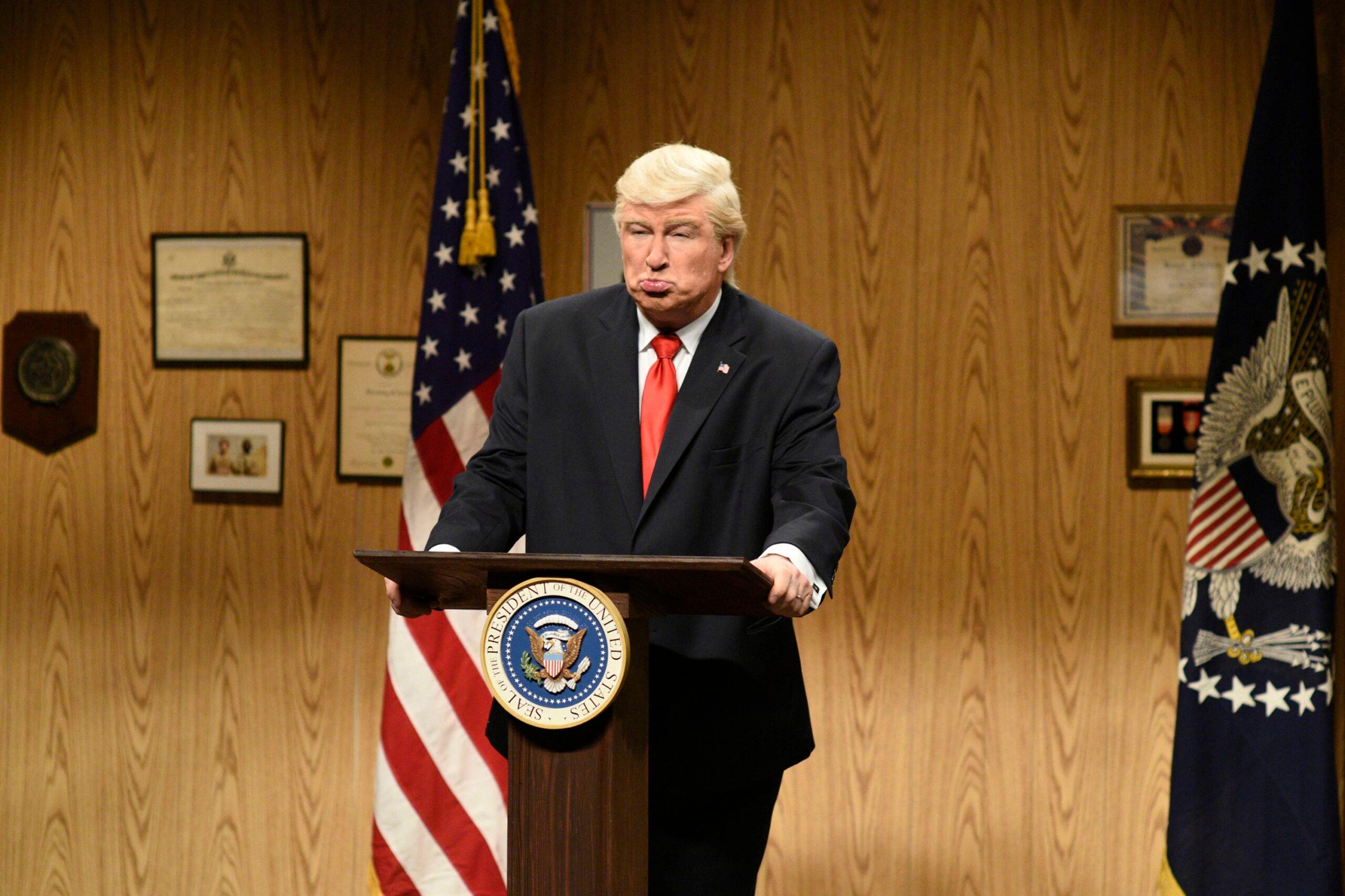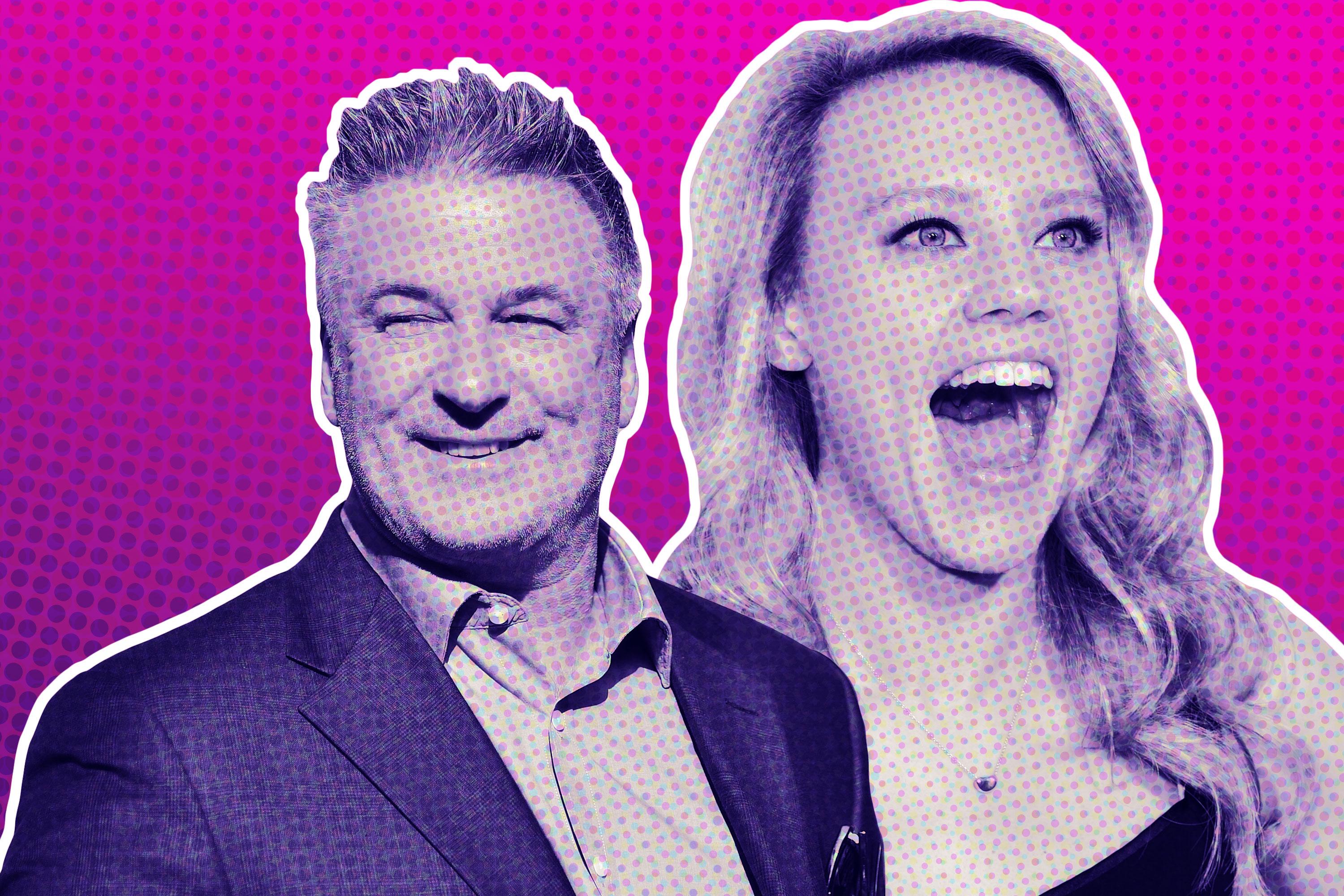Saturday Night Live has never had more eyes on it than it does going into its 43rd season. That’s true in a very literal sense: the comedy institution earned its highest weekly viewership in decades last season, closing out with a finale that hit a six-year ratings peak. And in the broader cultural sense, the Emmys recently showed, SNL is dominating conversations in a way it hasn’t since the country’s last pivotal election. Perhaps you remember Tina Fey’s uncanny resemblance to Sarah Palin?
Thanks to Kate McKinnon’s Hillary Clinton and Alec Baldwin’s Donald Trump, SNL found itself back in the spotlight, with an assist from Trump himself, who repeatedly demonstrated how deeply Baldwin’s impression got under his skin. In the process, the president unwittingly won SNL back some of the goodwill it had lost after inviting him to host in 2015. Both McKinnon and Baldwin won in their respective Emmy categories, a symbol of an SNL resurgence that papered over some deeper, systemic problems with the long-term health of the show—and also more than a few bright spots that had nothing to do with politics.
So when Ryan Gosling takes the stage on Saturday night, it might be the first time in his life those kind eyes and that perfectly groomed facial hair won’t be the true star of the show. SNL has a lot of expectations to either live up to or live down this year, and in preparation for what’s bound to be an especially scrutinized season, we’re breaking down what to keep an eye on in the weeks and months to come.
How Much Outside Help Is Too Much?
SNL’s unusual reliance on outside talent has been pointed out repeatedly over the past 18 months, but it bears revisiting on the occasion of Baldwin’s Emmy win. SNL has brought in alumni, affiliates, and other friends of the show to play topical roles before; Tina Fey had long since departed for 30 Rock when duty called her to portray Palin. But it’s never done so with the consistency it has in the Trump era, starting with the campaign, when Larry David played Bernie Sanders and Alec Baldwin took on the part everyone assumed would expire on November 9, 2016.
But then, obviously, plans changed. So Baldwin kept on, making nearly two dozen sketches over the course of the season that itself had only 21 shows. Melissa McCarthy stopped by to play Sean Spicer multiple times, and SNL decided to cast its Ivanka as guest host Scarlett Johansson. Johansson has yet to reprise her performance, and while Beck Bennett’s shirtless Putin is fun and Mikey Day and Alex Moffat have developed quite an enjoyable routine as Eric Trump and Donald Trump Jr., an overwhelming amount of the regular cast’s burden falls on McKinnon, who at one point did triple duty as Elizabeth Warren, Kellyanne Conway, and Jeff Sessions. (And that's in addition to her season-long run as Hillary Clinton.)

That leaves the question of just how long SNL’s central political impression can sustain itself, even as the demand for SNL’s political commentary escalates. I’ll be keeping an eye on whether Baldwin will be just as dependable a presence this year or whether the celebrity cameos slow down as the Trump administration starts to dull from shocking novelty to everyday reality. The ample press coverage that Baldwin has done (“It’s a narcotic for people,” he told New York of his performance) suggests he’s prepared to stick around for the long haul, but if 2016 taught us anything, it’s that nothing’s for certain.
What’s the Best Way to Do a Politics Sketch in 2017?
Long before 2016, the cold open was reserved for news-pegged spoofs, and SNL practically invented the Daily Show’s template with “Weekend Update.” Still, the knowledge that the president himself is probably watching and ready to fire off a response can’t help but up the ante.
SNL’s topical material can roughly be divided into three categories: the cold open, “Update,” and standard-but-still-timely sketches like “Black Jeopardy” or “A Day Off.” After a rocky start to the Michael Che–Colin Jost era of “Update,” SNL was confident enough in their performance to give them a summer spinoff, which reached its controversial peak with Tina Fey’s post-Charlottesville sheet cake. And since the cold open is where the Trump impressions usually happen, it’s an ever-more-reliable subject of post-show aggregation. But cold-open humor is often some of the show’s most obvious and transparently reactive; about half the jokes in this Lester Holt sketch are ripped directly from the headlines, right down to Day’s Paul Ryan serving up two scoops of ice cream. The Che-Jost “Update,” while stronger than it was in its awkward early days, is prone to clumsy, lazy jokes about, for example, why trans people are to blame for Trump’s victory.
The best of SNL’s political humor is often its weirdest and least direct: a Trump-supporting dog, or a perfume commercial for Ivanka’s Complicit. Without an automatic, prescheduled place on the show, these pieces tend to be fresher and less formulaic, though they lead to a fascinating paradox: SNL’s consistently best subcategory of topical humor is also its lowest-profile. I’ll be interested to see how far SNL continues to push itself creatively in the coming season, especially when the cold opens and “Update” are far more incentivized by the hype machine—and, in the case of “Update,” franchisable.
Really? More David S. Pumpkins?
Then again, politics is hardly the only arena where SNL’s proved itself more than willing to spread a joke too thin. NBC just announced a pre-Halloween special for one David S. Pumpkins, the goofy Tom Hanks character—catchphrase: “Any questions?!?!”—who’s popped up a grand total of twice. (Three times if you count Kevin Roberts, a preliminary version created by the same writers and played by Larry David.) Crucially, those appearances racked up nearly 9 million views on YouTube, and producers saw an opportunity. SNL has spun successful sketches into movies like Wayne’s World and Superstar, but rarely has it given a character stand-alone work with so little pre-existing material. It’s a combination of two trends: making non-cast members the center of attention and giving the internet what it wants. Chasing relevance means crowd-pleasing, and crowd-pleasing means tripling down on whatever makes an impact, whether it’s a sustainable premise or not. Whatever hits next season, expect more of it. Much more.
Who Is the Next Great Sketch Star?
There’s an unusual amount of pressure on Season 43’s new cast of featured players—this on top of the already legendary amount of pressure generated by SNL’s infamously Darwinian environment. SNL announced its three new hires earlier this week, and they each fill distinct cast archetypes. On one end of the spectrum is Chris Redd, a performer who’s already had a significant role in a studio film (he played a blatant Tyler, the Creator parody in the Lonely Island’s Popstar: Never Stop Stopping) and was already rumored to have been cast last year; in other words, he’s known, and known for being very funny. On the other is Luke Null, a musical comedian and almost complete unknown who apparently just had to quit his day job at a Chicago real estate company. And in the middle is Heidi Gardner, who’s graduating from the main company at Los Angeles improv theater the Groundlings, a historic breeding ground for superstars like Melissa McCarthy.
It’s a diverse sampling of talent, though the new cast is also notable for the things that they’re not: primarily stand-ups, like current success stories Leslie Jones and Pete Davidson, or part of a package deal, like Kyle Mooney and Beck Bennett, who are part of the sketch comedy group Good Neighbor. SNL is in particularly short supply of flexible, sketch-fluent players capable of both blending into the background and getting into sufficiently wacky character—someone like Phil Hartman, Bill Hader, or Kristen Wiig. (McKinnon, Bennett, and Aidy Bryant currently fit the bill, but so did Bobby Moynihan and Vanessa Bayer, who just left.) Individual performers who specialize in playing themselves are good in small numbers, but can erode a cohesive and internally fluid cast if they make up too much of the group; ditto self-contained units like the Island. Lorne Michaels appears to be placing his bets on new talent with a more traditionally SNL-friendly skill set. Best-case scenario: Together or in some combination, Redd, Gardner, and Null can grow into exactly the kind of sketch-oriented utility players SNL is in increasingly short supply of.
… Who Is the Next Writers’ Room Breakout?
Though both longtime writer Day and gifted impressionist Melissa Villasenor prospered in their debut season, one of the true Season 42 breakouts wasn’t a performer at all. Just a few months into his tenure as a writer, comedian Julio Torres earned a New York Times profile purely on the strength of his distinctive writing. The attention was well-deserved: Torres’s humor has an eerie loopiness that defies the show’s traditional writers’ room binary between, as Tina Fey once put it, “hyper-intelligent Harvard boys” and “visceral, fun performers.” He’s the mastermind behind “Wells for Boys” and “The Sink,” sketches that immediately announce themselves with a distinctive rhythm and melancholy weirdness. Torres could even bend topical material to his singular voice, inaugurating the franchise “Melania Moments.” He’ll be someone to watch for Season 43, both at SNL itself and the various NBC properties where he’s been popping up to do stand-up.
There’s also the new class of writers, which includes Leslie Jones collaborator Erik Marino, successful stand-up Sam Jay, and Nimesh Patel, who helped write for Hasan Minhaj’s White House Correspondents’ Dinner earlier this year. On SNL, cast members tend to get all the attention—understandably, since sketches don’t have bylines and remain anonymous until individual writers claim credit—but as writing alumni from Larry David to Mike Schur to John Mulaney have shown, it’s worth keeping an eye on what’s happening behind the scenes as well. SNL values writer-performers, yet pure writers exert an enormous influence over the tone of the show; Kate McKinnon credits creative partners and cohead writers Chris Kelly and Sarah Schneider with many of her Hillary sketches. And as Tina Fey or Colin Jost could tell you, writers are just as often a talent pool for SNL itself as the rest of scripted television.
… And Who Is the Next Exit?
This year, Kenan Thompson will break Darrell Hammond’s previous record with his 15th full season on SNL. But the show has already lost some of its most seasoned veterans: Bobby Moynihan, who left to headline the CBS sitcom Me, Myself & I, and Vanessa Bayer, who seems poised to pursue movie roles.
That leaves a new senior class in place: Kate McKinnon, the obvious next candidate to splinter off, plus Cecily Strong, Bryant, Bennett, and Mooney. SNL should be most worried about McKinnon’s surely imminent departure—if not this season, then surely in the next couple of years—but there’s reason to keep an eye on someone like Mooney, with a distinctive voice that’s never quite jelled with the rest of the show. He’s started to use that voice on projects like this summer’s excellent Brigsby Bear, which harnessed his instantly identifiable comedic tics for pathos and drama rather than pure laughs. Then there’s Bryant, who’s taking the more conventional, gradual route of slowly ramping up her outside roles, including a supporting part in The Big Sick.
SNL has a bench problem that’s been in the making for years: star power and even flexibility is clustered in the hands of a few performers, which is standard on a show that only has so much spotlight to go around. But unlike in most previous generations, the show’s famous kingmaking apparatus hasn’t yet successfully cultivated an obvious group to pass the torch to. The good news: SNL’s next chance starts on Saturday.
